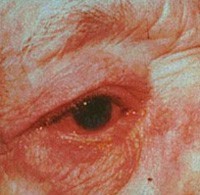 New research into the development of subtype 4 ocular rosacea has found a strong correlation between certain components of the innate immune system and abnormalities in the blood vessels of the eyelids and eyes of those who suffer from the disorder.
New research into the development of subtype 4 ocular rosacea has found a strong correlation between certain components of the innate immune system and abnormalities in the blood vessels of the eyelids and eyes of those who suffer from the disorder.
The study was led by Dr. Edward Wladis, who was the recipient of a 2011 research grant from the NRS. The researchers investigated toll-like receptor-4 (TLR4) as well as a variety of vascular markers in eyelid biopsies from patients with ocular rosacea and individuals without the condition.
They found that levels of TLR4, proteins which play a key role in activating the innate immune system, were much higher in people with ocular rosacea. In addition, there were higher amounts of endoglin and a molecule that helps cells adhere to each other in the small blood vessels of ocular rosacea patients compared to those with normal skin. These molecules may cause inflammation in the blood vessels, leading to the bloodshot appearance common with ocular rosacea.
The researchers concluded that these molecules may represent targets to focus on therapies to help manage ocular rosacea.